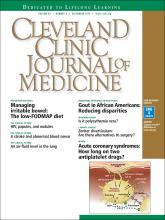ABSTRACT
For patients with an acute coronary syndrome event, current guidelines recommend dual antiplatelet therapy for at least 12 months after drug-eluting stent placement. However, several clinical trials have assessed whether continuing dual antiplatelet therapy beyond 12 months is beneficial. We review the pros and cons of extending dual antiplatelet therapy.
Footnotes
Dr. Lincoff has disclosed research support from AstraZeneca, CSL Behring, Edwards LifeSciences, Eli Lilly, Esperion, Medtronic, Pfizer, Regado, Roche, and Takeda and consulting and membership on advisory committees or review panels for Roche.
- Copyright © 2016 The Cleveland Clinic Foundation. All Rights Reserved.
- Meghana Halkar, MD⇑
- ADDRESS:
Meghana Halkar, MD, FACP, MedStar Heart and Vascular Institute, MedStar Washington Hospital Center, 106 Irving Street, Washing-ton, DC 20010; meghanahalkar{at}gmail.com
- A. Michael Lincoff, MD
ABSTRACT
For patients with an acute coronary syndrome event, current guidelines recommend dual antiplatelet therapy for at least 12 months after drug-eluting stent placement. However, several clinical trials have assessed whether continuing dual antiplatelet therapy beyond 12 months is beneficial. We review the pros and cons of extending dual antiplatelet therapy.
Footnotes
Dr. Lincoff has disclosed research support from AstraZeneca, CSL Behring, Edwards LifeSciences, Eli Lilly, Esperion, Medtronic, Pfizer, Regado, Roche, and Takeda and consulting and membership on advisory committees or review panels for Roche.
- Copyright © 2016 The Cleveland Clinic Foundation. All Rights Reserved.






